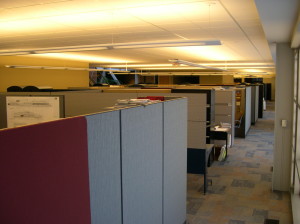
Back in the day, I worked for an office furniture manufacturer. At the time, the open office plan developed by Robert Propst was in full swing. The benefits were many: more collaboration between different departments, increase innovation and a lower cost of capital expenditure.
In many aspects, the tweaking of “who sits where” is a social experiment, with senior leadership deciding which configuration of workspaces and employees will reap the most benefit. The latest trend in this game of musical office chairs is to switch people up more frequently. According to the Wall Street Journal, some companies are moving employees every few months and in some cases, are doing so randomly, mixing up different departments and functions. Proponent of this approach say that it fosters innovation and can even save money.
Of course, there are downsides to this approach too. The very thing that upper management seeks – increased casual conversations – leads to more interruptions. And that decreases productivity. A different WSJ article highlights the perils of this interrupted workflow which leads to increased fatigue, distraction and lost productivity. One researcher found that it can take up to 25 minutes for people to get back “into the flow” after an interruption.
Here’s my take: executives should proceed with caution. As a person who has worked in the contract furniture industry and seen the extensive research on the how workers work, this is not an issue to take lightly. “Shaking things up” is always far more interesting and comfortable to the Shaker than Those Being Shaken. Yes, there are benefits to this form of change management. But those implementing the change better weigh the benefits with the drawbacks, because there will be plenty of both.
Finally, I would remind managers of this: musical chairs, when played to the end, has only one winner – the last person left seated on the sole chair. Is this really the tone executives want to foster?
Photo credit: morgueFile
Leave a Reply